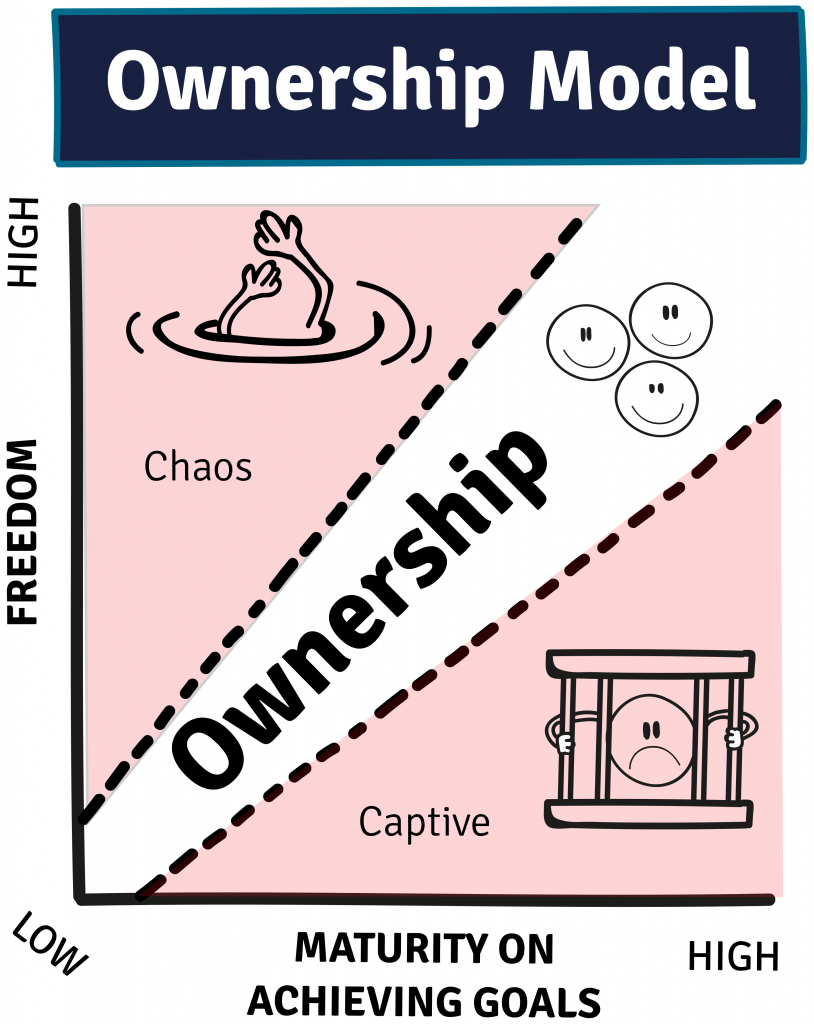
Ownership workshop
Let's make it practical
Goal
The goal of the workshop is to:
- Have a common understanding of what (psychological) ownership is,
- And to have a first version of the Ownership-model
Facts
- Group size: 5 - 20
- Time needed: 2-3 hours
- Materials needed: post-its
- Preparation by the people: none
- Preparation by the facilitator: 1 hour
2 - What is freedom?
Using the method of 1-2-4-all (Liberating Structures) the group talks about the question "What is freedom?"
Why is this important? People can only take ownership of something, if they have enough freedom to make decisions, plan the work, decide on priorities and collaborate. This is impossible without Freedom.
1 - Intro exercise - why freedom?
In this exercise, the people of the workshop will stand in Isosceles triangles.
The exercise consists of two rounds. In the first round a manager does the coordination, in the second round, the people will have to manage themselves. The facilitator measures the time needed.
Intro
- The facilitator asks everybody to take (in their mind) two persons in the room.
- The facilitator explains what a isosceles triangle is (the distance to person 1 is the same as the distance to person 2).
Round 1 - manager
- The manager is asked to (within 5 minutes) to put everybody into isosceles triangles.
- He/she probably asks the first person to give the two persons in her/his mind
- The manager puts the two persons into isosceles triangles (by asking them to move)
- And the manger goes to the other persons one by one.
Self-managing
- The facilitator asks everybody to take two different persons.
- The facilitator explains that nobody is allowed to speak nor give non-verbal instructions to others
- The facilitator asks the group how much time they think they need to do this without coordination. Some people might say `impossible', others `a few minutes'.
- The facilitator records the time needed
Reflection
The group speaks together and shares observations and lessons learned. The main lesson should be: when the work is too complex, you need more people to think-along and not just one person giving orders or instructions.
3 - Watch video 'Drive by Daniel Pink'
The group watches the video from Daniel Pink, called The suprising truth about what motivates us
.Reflection
The group has an open discussion on what they liked about the video and how that relates to their situation.4a - What is Ownership?
Exercise: 1-2-4-all (or another format) the group shares ideas on what Ownership is.
If you want, you can show this video too
4b - What builds and kills ownership?
The group shares thoughts and ideas on what builds and kills ownership.
On a flip-over, the most important things are written down.
Probably the following items will be mentioned:
- Alignment/Involvement: how much you feel involved in the work you do, for the company
- Self confidence: how much you feel like an important link in the organisation
- Eagerness: how much you want it, to get the job done
- Responsibility: how much you feel responsible for your work
- Personal development: how much you increase your knowledge
- Org empowerment: how much you feel strengthened in the performance of your work
- Mutual trust: how much confidence you feel in the cooperation/collaboration within the team
- Bringing in new ideas: how much you feel invited to improve yourself and the organisation

5 - Relation Freedom and Ownership
The facilitator draws two axes on a flipchart:
- Vertical: Freedom
- Horizontal: Maturity
The facilitator asks the group: 'What will happen with a team that is new, just started and get's infinite freedom; can almost decide everything'. The things mentioned are written down.
Then the facilitator asks the group: 'What will happen with a team that is hugely mature, worked together for years. A new manager comes and start to micro-manage the team?'
`What happens with a team that is just started, but gets a lot of help, clarity and can decide not too much?'
etc.The facilitator sparks a group discussion on the ownership-model.
6 - Plot teams or teammembers
In subgroups, people plot teams or team-members on where they are on the Ownership Model. These subgroups have a lively discussion on whether teams have too much, too little or the right amount of freedom.
These subgroups will also probably discuss 'what does it mean to be highly mature? How do you recognize teams' maturity?
Wrap-up and close
Last, but not least, the facilitator asks feedback on this workshop and what the group members will never forget.Next steps ...
This is step 1 of making the Ownership Model very practical




